| Srl | Item |
| 1 |
ID:
172564
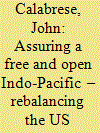

|
|
|
|
|
| Summary/Abstract |
Borrowing the term ‘Indo-Pacific’ from Japanese Prime Minister Shinzo Abe and refashioning the Obama ‘Pivot to Asia’ or ‘Rebalance Strategy’, the Trump administration has articulated a vision of a Free and Open Indo-Pacific (FOIP), which, as its public discourse and official documents reveal, is defined through the lens of great power competition with China. Since the latter part of 2017, the administration has laid the groundwork for a whole-of-government approach aimed at advancing this vision, which consists of three pillars: economy, governance, and security. Southeast Asia – a dynamic sub-region and the fulcrum of the wider Indo-Pacific – is central to the evolving US strategy. However, in its current form, that strategy casts China in the role of an existential threat and economic enemy, and seems overly focused on military security. For these reasons, it is unlikely to garner the full support of allies and partners – without which shared prosperity, good governance, and a peaceful and secure regional order across the Indo-Pacific cannot be assured. A repositioning and repurposing of the recently resuscitated Quadrilateral Security Dialogue (or Quad) could transform this minilateral platform into a useful instrument to coordinate the four members' actions, leverage the capabilities of Quad-Plus countries, and engage ASEAN in managing non-traditional security challenges and furthering its connectivity agenda.
|
|
|
|
|
|
|
|
|
|
|
|
|
|
|
|
| 2 |
ID:
120692
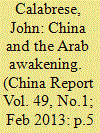

|
|
|
|
|
| Publication |
2013.
|
| Summary/Abstract |
The popular unrest that has swept the Arab World since January 2011-occurring as China entered a period of leadership succession and delicate economic adjustment-presented Beijing with both domestic political and diplomatic challenges. This article examines how, and how well, China responded to the Arab Awakening at home and in the conduct of its diplomacy.
|
|
|
|
|
|
|
|
|
|
|
|
|
|
|
|
| 3 |
ID:
066949
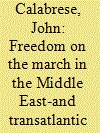

|
|
|
| 4 |
ID:
186311
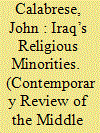

|
|
|
|
|
| Summary/Abstract |
The Middle East and North Africa (MENA) is often described as the cradle of the three Abrahamic faiths and Iraq as a land “where faith was born.” But the past two decades have dealt a severe, possibly fatal blow to religious communities that were once vibrant and integral parts of Iraq’s social fabric—and perhaps to the very idea of pluralism in the region. Ensuring the continued presence of religious minority communities is vital to preserving Iraq’s social diversity and nurturing a culture of pluralism. Iraq’s best hope to save its vanishing minorities from extinction and revive religious pluralism lies in the Iraqi Region of Kurdistan (IRK). Fully incorporating displaced non-Muslim components of Iraqi society into host communities in the IRK while preserving their distinctive collective identity would advance the prospects for the survival of religious minorities and the future of pluralism in the IRK, the country at large, and the wider region.
|
|
|
|
|
|
|
|
|
|
|
|
|
|
|
|
| 5 |
ID:
182838
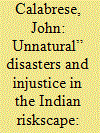

|
|
|
|
|
| Summary/Abstract |
The vulnerabilities that turn natural hazards such as hurricanes and earthquakes into disasters are rooted in inequality. The overarching aim of this article is to shed light on the nexus between social justice principles and the mitigation of disaster impacts. The article uses ‘disaster justice’ – an offshoot of ‘environmental justice’ – as a conceptual lens to help enrich understanding of the differential impacts of disasters upon communities and to craft more inclusive policies and programmes. In India, among the world's most disaster-prone countries, as elsewhere, there is growing recognition that children and youth, who assume a disproportionate share of the burden created by disasters, are an underutilized demographic force multipliers for disaster risk reduction. The country's multi-hazard risk and vulnerability profile has led Indian non-governmental organisations (NGOs) not just to provide post-disaster relief but increasingly to integrate into their work programs designed to unleash the potential of young people to develop the resilience of their communities.
|
|
|
|
|
|
|
|
|
|
|
|
|
|
|
|